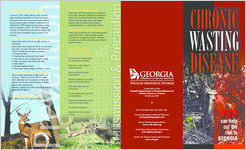What is the State of Georgia doing to prevent the introduction of CWD? As early as 2001, DNR staff and other agencies began developing guidelines on how to prevent the disease from occurring in the state as well as making response plans should an infection occur. Additionally, DNR began proactive annual testing of harvested deer in 2002. If CWD is detected, Georgia will benefit from these survey efforts and can take more immediate steps to counter the problem.
What restrictions currently are in place? n Importation of any live cervid (deer species) is
prohibited. n Importation of any whole cervid carcass or carcass
parts from any state with a documented case of CWD is prohibited with these exceptions: 1.) boned-out meat; 2.) commercially processed cuts of meat; 3.) meat with no part of spinal column or head; 4.) clean skull plates with antlers attached; 5.) clean antlers; 6.) finished taxidermy heads; 7.) clean upper canines (buglers, whistlers, ivories).
How can I help prevent CWD in Georgia? n Report illegal importation of deer species or
carcasses: 1.800.241.4113 or 770.761.3044. n Don't feed deer: this unnaturally concentrates
animals and increases the likelihood of disease and parasite transmission. n Maintain a healthy local deer population through adequate doe harvest.
What should I do if I observe or harvest a deer that exhibits CWD symptoms? Call 1.800.241.4113 or 770.761.3044 or visit www.gohuntgeorgia.com
How is the disease transmitted? The mode of CWD transmission is unknown at this time. Research indicates that infectious prions are excreted through saliva and feces. Transmission may then occur when other animals come in contact with or ingest contaminated grass or other food sources.
Is the disease transmissible to humans? There are no verified cases where humans have contracted CWD either through contact with deer or by ingesting venison. However, it remains a possibility and precautions should always be taken.
Precaution Suggestions
Do not harvest or handle animals that appear sick or unhealthy
Wear latex or rubber gloves to minimize exposure
Bone out all meat and avoid severing bones
Minimize handling of brain, tonsils, spinal cord and lymph glands
Thoroughly clean hands and sanitize tools
Do not consume brain, spinal cord and lymph glands
Process deer individually, and add no meat from other animals
Do not split the backbone
Designate one tool for removal of head
Hunters Taxidermists Deer Processors
A publication of the Georgia Department of Natural Resources,
Wildlife Resources Division Revised: June 2009
n
For more information, visit these sites:
Georgia Department of Natural Resources www.gohuntgeorgia.com
Chronic Wasting Disease Alliance www.cwd-info.org
United States Department of Agriculture www.aphis.usda.gov
Centers for Disease Control and Prevention www.cdc.gov
YOU
can help cut the risk in
Georgia
Chronic Wasting Disease is a contagious neurological disease that causes severe brain degeneration of infected animals, resulting in death. It belongs to a group of diseases called transmissible spongiform encephalopathies (TSE) that include scrapie (sheep), mad cow disease (cattle) and Creutzfeldt-Jakob disease (humans).
Where did the disease originate? CWD was first detected in a captive herd of mule deer in the late 1960s, but not recognized as a TSE until the 1970s. It is currently unknown where it may have originated.
What causes it and what animals are affected? Experts believe the disease occurs when an abnormal form of cellular protein, called a prion, converts normal proteins to abnormal ones. It mostly has been found in white-tailed deer, mule deer, elk and moose. However, any member of the cervid (deer) family is potentially susceptible. Research is ongoing.
What are the symptoms? Symptoms may include emaciation, listlessness, lowered head, blank stare, excessive salivation, and staggering or circling.
What states have infected cervid (deer species) herds? As of May 2009, 15 states and 2 Canadian provinces have documented cases of CWD. This number is likely to increase. For a current list of infected states and provinces, visit www. cwd-info.org
Is CWD in Georgia? To date, there have been no verified cases of CWD in Georgia or any of the surrounding states. West Virginia is the nearest state to have a confirmed case of CWD (as of May 2009).
Who should be concerned? Anyone interested in wildlife (hunters, wildlife watchers, others), business owners (processors, hunting lodges or guides, outdoor sports business operators) and consumers of venison.
Credit: Wisconsin Department of Natural Resources
Credit: Wisconsin Department of Natural Resources
Brain Eyes
Tonsils Spleen
Lymph Nodes Spinal Column
Tissues Affected by CWD
Lymph Nodes
CWD in North America
Areas with CWD infected Cervid populations
States/Provinces where CWD has been found in captive populations
Credit: Chronic Wasting Disease Alliance (www.cwd-info.org)
